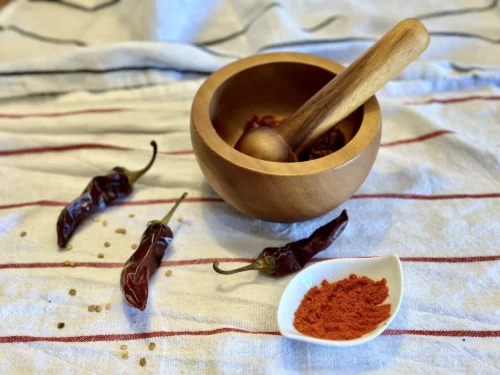- No. 268 Xianghe Street, Economic Development Zone of Xingtai city, Hebei 054001 China
- Byron@hbhongri.cn
paprika seasonings
The Versatility of Paprika A Spicy Exploration of Seasonings
Paprika, a vibrant red spice derived from ground peppers, is a staple in many kitchens around the world. Originally from Central America, it has become a beloved seasoning in European, Mediterranean, and Middle Eastern cuisines. Its unique flavor profile and stunning color make it a favorite among chefs and home cooks alike. This article delves into the types of paprika, its culinary uses, health benefits, and tips for incorporating it into your cooking.
Types of Paprika
There are several varieties of paprika, each offering a distinct flavor and heat level
. The most common types include1. Sweet Paprika This is the most popular variety, known for its mild flavor and bright red color. Sweet paprika is often used to add color to dishes without an overpowering spiciness, making it perfect for enhancing soups, stews, and sauces.
2. Smoked Paprika Also known as pimentón, this type is made from peppers that have been dried over an oak fire. It has a rich, smoky flavor that adds depth to dishes. Smoked paprika is frequently used in Spanish cuisine, particularly in paella and chorizo, and can elevate the taste of grilled meats and vegetables.
3. Hot Paprika For those who enjoy a spicy kick, hot paprika packs a punch. This version is made from spicier pepper varieties and can bring heat to dishes like goulash, chili, and various marinades. It’s an excellent choice for people looking to add a bit of excitement to their cooking.
4. Hungarian Paprika Renowned for its quality, Hungarian paprika is classified into several grades based on sweetness and heat. The most famous is Noble Sweet paprika, used extensively in traditional dishes such as goulash and paprikash.
5. Spanish Paprika With a focus on flavor diversity, Spanish paprika can range from sweet to hot and usually has a slightly smoky profile. It's essential in Spanish cuisine and is commonly used in dishes like patatas bravas and various sauces.
Culinary Uses
paprika seasonings

The versatility of paprika makes it suitable for a wide range of culinary applications. It can be sprinkled on deviled eggs for a pop of color, added to potato salads for a warm flavor, or stirred into marinades for grilled proteins. In sauces, paprika can be the star ingredient, providing richness and color; consider using it in traditional sauces like romesco or even in a creamy garlic sauce.
Moreover, paprika can enhance the taste of roasted vegetables. Toss a variety of vegetables in olive oil, sprinkle them with paprika, and roast until tender. The spice not only adds a gorgeous hue but also a subtle warmth that complements the natural sweetness of the vegetables.
Health Benefits
Beyond its culinary applications, paprika also boasts several health benefits. It is rich in antioxidants, particularly carotenoids, which contribute to eye health and skin protection. Paprika contains vitamins A, E, and C, along with minerals like iron and magnesium. These nutrients support various bodily functions, including immune health and blood circulation.
Additionally, the capsaicin found in some varieties of paprika, particularly hot paprika, may offer anti-inflammatory effects and has been studied for its potential role in pain relief and weight management. Incorporating paprika into your diet can not only enhance flavor but also add nutritional value.
Tips for Cooking with Paprika
1. Storage Paprika should be stored in a cool, dark place in an airtight container to preserve its flavor and color. Whole peppers can be kept longer than ground paprika, which tends to lose potency over time.
2. Layering Flavors To maximize the flavor of paprika in your dishes, consider adding it at different stages of cooking. A pinch can be added at the beginning to infuse the oil, while a dash at the end can brighten the flavors.
3. Experimentation Don’t hesitate to experiment with different types of paprika in various cuisines. Whether you’re making a traditional Hungarian stew or a modern roasted vegetable dish, there’s a type of paprika that can elevate your recipe.
In conclusion, paprika is a dynamic seasoning that can transform any dish with its color and flavor. Whether you prefer sweet, smoked, or hot varieties, this spice should be a staple in your pantry, ready to enhance your culinary creations. Embrace the world of paprika, and you may just discover a new favorite ingredient to bring your meals to life!
-
Turmeric Rhizome Powder: A Golden Treasure from Roots to TableNewsJul.28,2025
-
The Versatile Application Of Crushed Red Hot Peppers: Lighting Up The Red Flames On The Dining TableNewsJul.28,2025
-
The Paprika: A Touch Of Vibrant Red In Color, Flavor, And CultureNewsJul.28,2025
-
Ground Turmeric: A Modern Examination of an Ancient SpiceNewsJul.28,2025
-
Capsicum Liquid Extract: Features, Applications, and ChallengesNewsJul.28,2025
-
Application of Capsicum Liquid Extract in FoodNewsJul.28,2025







